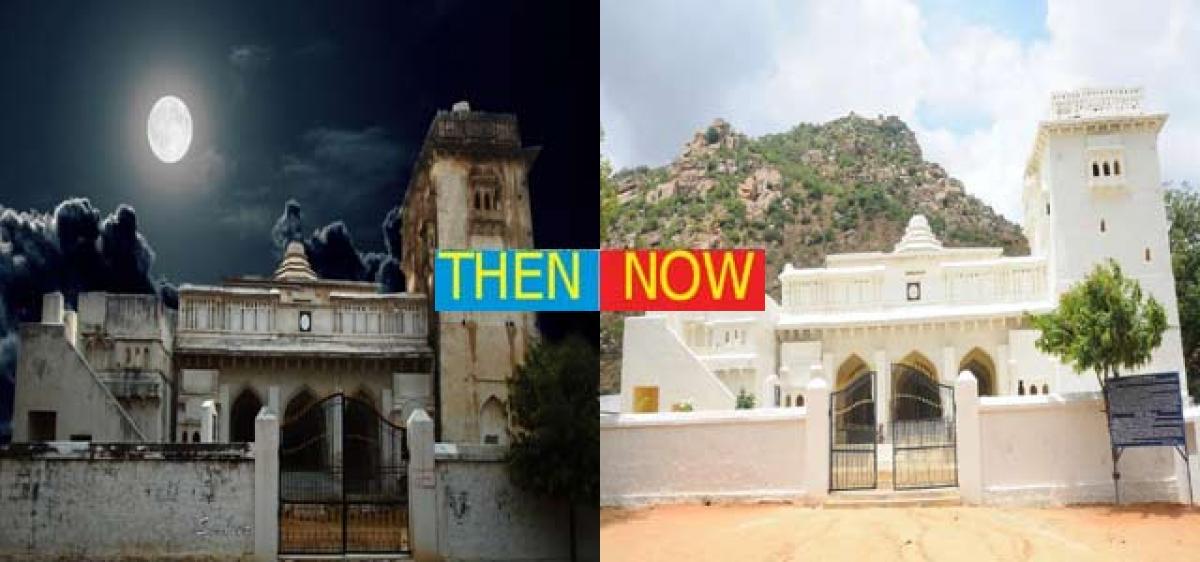Live
- BJP releases ‘charge sheet’ against BJD govt
- District Nodal Officer Venkataramana announced the intermediate results
- She team that stopped child marriages
- Medical devices sector needs separate rules, says industry body AiMeD
- Andhra Paper declares lockout
- Opposition INDIA bloc working on 'one year, one PM' formula: PM Modi
- Delhi HC quashes FIR for outraging woman's modesty, orders man to assist Traffic Police for a month as settlement
- 'Apologise to families of farmers who committed suicide in Vidarbha', Amit Shah dares Sharad Pawar
- SC Collegium recommends appointment of a permanent judge in Chhattisgarh HC, extension of term of two judges
- U20 Men's football nationals: Telangana, Sikkim earn full points with easy win
Just In

The legendary 16th century royal palace located in Penukonda, known as Gagan Mahal, built during the Vijayanagar period which was the second capital of Emperor Sri Krishna Devaraya, has now an eye-feasting look after getting a facelift and restoration of its pristine glory by the Department of Arche0logy and Museums.
Penukonda (Anantapur): The legendary 16th century royal palace located in Penukonda, known as Gagan Mahal, built during the Vijayanagar period which was the second capital of Emperor Sri Krishna Devaraya, has now an eye-feasting look after getting a facelift and restoration of its pristine glory by the Department of Archeology and Museums.
The palace, which was in a dilapidated condition, is now the cynosure of all and part of tourist circuit of the Tourism department. The department has restored its past glory with the help of architects from Tamil Nadu.
Legend has it that a beautiful royal dancer, Gangamma, made Gagan Mahal her abode for entertaining the visiting kings and dignitaries.
The architecture of Gagan Mahal is a combination of Hindu and Persian and the same is now renovated by the department of Archaeology without disturbing its original beauty.
Once resembling eerie, ghost-infested palace shown in horror movies, Gagan Mahal now houses a photo exhibition reflecting the history of Penukonda, the second capital of the legendary emperor.
The palace is now an ideal spot for film shootings, the locals say. Number of religious structures have been added at the palace during the Vijayanagar period.
The people of Penukonda, who are proud of its rich cultural and political heritage, are sad at the utter neglect of the historical town by the Central and the State governments.
The very soil of the ancient rustic town is a witness to the grandeur of its rich past, says Kulayappa, an octogenarian, who has been a resident of the town for the past eight decades.
The government has starved the department of Archeology of funds. Recent reports say the department itself is being wound up as it is considered a white elephant.
Another senior citizen Narayanappa sipping tea at a kiosk seconds the observations of Kulayappa. History is being erased by the utter neglect of Archeology department, the story teller to future generations, he lamented.
In the residential fort area, the temples dedicated to Rama, Siva, Mukteswara, Parswanatha, Narasimha, Venkateswara, Kali, mosques, Thimmarasu jail, mathas, watch towers, Vykuntapuram, water tanks and Gagan Mahal are important structures.
Gagan Mahal is the only structure under the control of Archeology and Museums department. The ancient Hindu palace Gagan Mahal is located to the south of Ramaswamy and Eshwara temples.
It was the summer palace of harem of Vijayanagaram rulers. The building, facing east and composes of two-storeyed arcade chambers, square on plan with corner tower on the northern side.
In front of the building there are steps leading into the building and staircases on either side leading to first floor. The ground floor consisting of recessed 45 arches in the pavilion reminiscent of the Lodhi type of arches of Delhi.
The middle of the ground floor and the first floor made a provision of rooms. The first floor has 12 arches and eight windows. The surface of the walls of building is coated with stucco.
The pyramidal roof built-up in tiers is obviously adopted from Sikhara of the Dravidian style. The tower has six projecting windows supported by brackets.
It was built by a combination of Indo-Persian architectural style adopted by Vijayanagara kings. The palace was built without a single rafter, a unique specimen architecture.

© 2024 Hyderabad Media House Limited/The Hans India. All rights reserved. Powered by hocalwire.com







